-
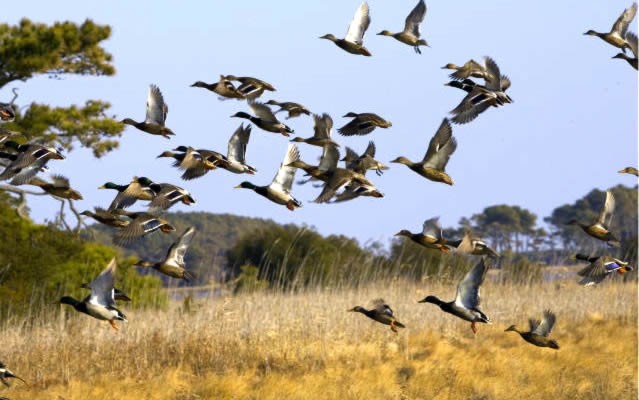
Waterfowl
Waterfowl are commonly encountered in clinical practice as backyard fowl, pets, zoo specimens, or as injured wildlife. Waterfowl belong to Family Anatidae, which includes swans, geese, and ducks. Ducks are divided into two categories: dabbling ducks and diving ducks.
- Dabbing ducks surface feed or tip up in shallow waters. Dabbling ducks also take off for flight from the water surface at an acute angle. The legs are relatively centered on the body.
- Diving ducks primarily feed by diving into deep water. These species must ‘run’ across water while flapping their wings to take off. Consequently the legs are located more caudally on the body.
-
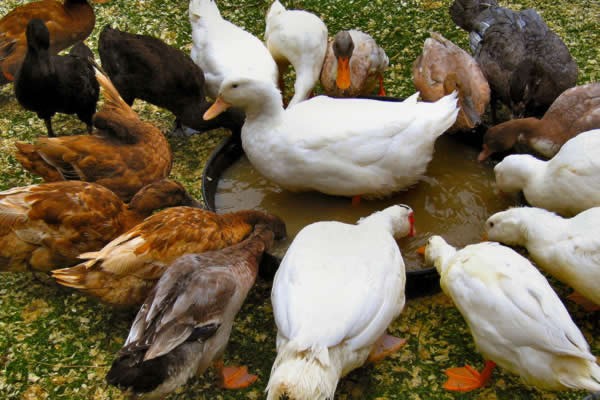
Domestic Ducks
Ducks have been domesticated for thousands of years as a source of meat, eggs and down feathers. All domestic ducks are descended from the mallard (Anas platyrhynchos) except the Muscovy (Cairina moschata), which is a member of the perching duck family. Domestic ducks kept as pets live an average 8-12 years.
-

Pekin Duck
Also known as the Long Island duck, the Pekin duck was first introduced to the United States from China in 1873. The Pekin is the most popular domestic duck in America. This commercially raised duck is used primarily for egg and meat production. Pekin ducks range in weight from 3.2-5.4 kg (7-12 lb). Males are heavier than females. Unlike most ducks, Pekin ducks are sexually monomorphic. All Pekin ducks possess white feathers with orange legs, feet and bill. Ducklings are yellow. FYI: “Peking duck” is a well-known duck food dish from Beijing that has been prepared since the Imperial Era, and is now considered one of China’s national foods. Image provided by Joe Roberts.
-
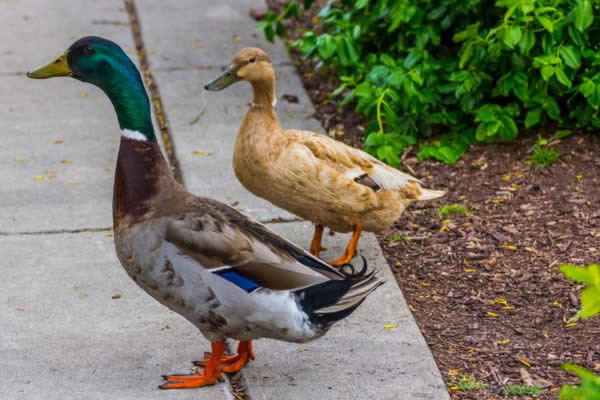
Khaki Campbell Duck
A Mrs. Adele Campbell of Gloucestershire, England developed the Khaki Campbell breed in the 1800’s. First recognized by the American Poultry Association in 1941, Campbell numbers increased dramatically in the United States in the 1970’s. Khaki Campbells are one of the world’s most prolific egg laying breeds producing an average 250-340 eggs per year. This streamlined, medium-sized bird weighs 1.8-2.0 kg (4-4.5 lb). Campbells have a modestly long head, bill, neck, and body, and a sprightly body carriage of 20 to 40 degrees above horizontal.
- The Khaki drake (male) has a green bill, rich dark orange legs and feet, and dark brown eyes. Its head, upper neck, lower back, and tail coverts are bronze-brown. The rest of the drake’s plumage is a warm khaki color.
- The Khaki duck (female) has a green bill, dark brown eyes, and brown legs and feet. Her head, upper neck, and lower back are seal-brown and the rest of the plumage is khaki.
The Campbell duck is a high-strung, active bird that needs plenty of space to graze and forage. Campbells are amazingly adaptable, performing well in environments ranging from desert to tropical rainforest to cold Northern regions. Photograph by Dobis Images
-
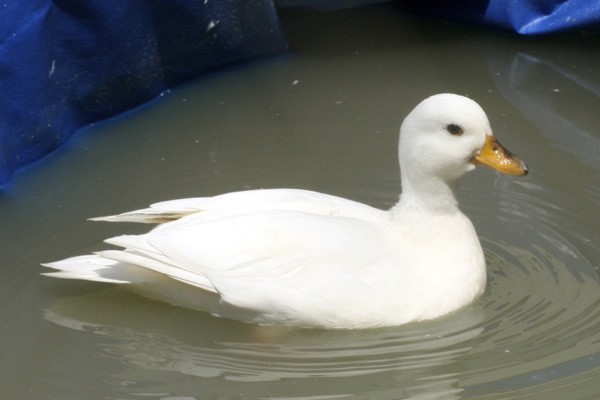
Call Duck
Originally imported from Asia, call ducks were developed as decoy ducks to attract wild mallards to the great traps in the United Kingdom (UK) and Holland. First standardized in the UK in 1865. Call birds became popular show birds in the 1970’s. The call duck is the smallest breed of domestic duck, weighing approximately 0.7 kg (1.5 lb). This bantam breed is raised primarily as an ornamental species or as pets. Call ducks make good pets although females do have a very loud quack, making them a poor choice in an urban setting. Image by ‘Just Chaos’
-
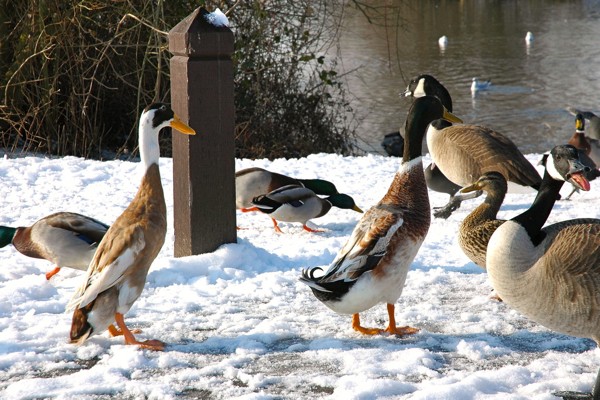
Indian Runner Duck
Ancient Javan temple carvings indicate that Runner-like ducks existed in Indo-China 2000 years ago. Runner ducks or Indian runner ducks were first imported into Great Britain in the 1800’s.
The slim body and long neck of the Indian runner has been compared to a “wine-bottle with a head and legs”. The runner duck weighs 1.8-2.0 kg (4-4.5 lb). The head is slender with eyes set high, the bill is straight, and the legs are set far back on their bodies creating a characteristic upright carriage of 45-75 degrees above horizontal. When agitated some runners stand perpendicular to the ground. There are more color types of runner ducks than any other breed.
Bred to be good walkers, excellent foragers, and prolific layers, good strains will lay more than 200 eggs annually. Runner ducks are active birds, covering a large area in search of snails, slugs, and insects. Runners also make excellent show birds and entertaining pets.
Image by ‘steve p2008’
-

Muscovy Duck
The Muscovy duck (Carina moschata) is native to Mexico, Central, and South America. The domesticated Muscovy has feral populations in the southern (e.g. Texas) and southeastern (e.g. Florida) United States.
The Muscovy is a large, heavy-bodied bird with broad wings, short legs, strong claws, and a long, broad tail. Muscovy ducks have brown-black feathers with green and purple iridescence and white wing patches. Legs and feet are gray-black and the iris is yellow-brown.
Males and females are similar in appearance except that males are nearly twice as large as females. The average male weights 3 kg (6.6 lb); females weigh 1.5 kg (3.3 lb). Domestic birds are usually heavier than wild birds. Domestic birds also tend to have patches of white on the head and body and a redder face. Some domestic birds are completely white.
The Muscovy is a perching duck. Free-ranging birds prefer sheltered water (ponds, rivers, or swamps) covered by trees. The Muscovy is not cold adapted and can develop frostbite.
Image of a domestic Muscovy duck by ‘ceiling’.
-

Rouen Duck
The Rouen duck is a domestic duck breed originally raised by French farmers. Selective breeding in England redesigned the bird by doubling its size, transforming its body into a thick, boat shape, and modifying its colors. The Rouen was brought to the United States in 1850 and the breed soon became popular as a farm duck.
Shown here is the standard Rouen, a large, blocky duck that reaches 3.6-4.5 kg (8-10 lb). It has a horizontal carriage, a deep, level keel, and its back arches from shoulders to tail. The head is round with a medium size bill that is concave along the top line. The production Rouen is a trimmer bird with a more upright carriage that typically weighs 0.9 kg (2 lb) less than the standard Rouen.
- The Rouen drake has a dark yellow bill, bright orange shanks and feet, and black eyes. His head, upper neck, and tail are dark green, lower neck and breasts are dark brown, upper back is dark gray, and lower body light gray. A white band encircles his neck and a diagonal white/blue/white line crosses his wings.
- The Rouen duck has a brown bill, dark orange shanks and feet, and black eyes. She also has the diagonal white/blue/white color pattern on her wings but the rest of her plumage is brown with black texturing.
Rouens are docile birds that are valued for their meat, however Rouen ducks are slow to mature (6-8 months).
Female Rouen shown here.
-
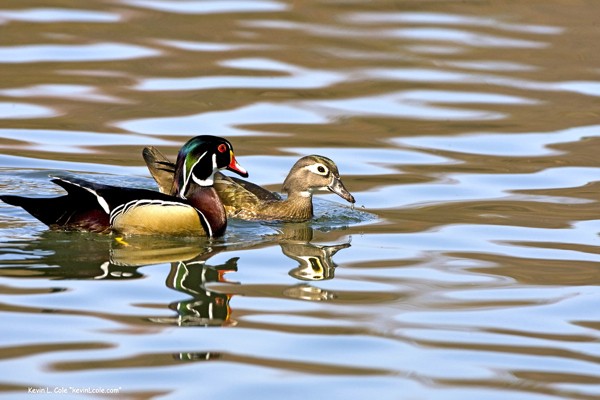
Wood Duck
The wood duck (Aix sponsa) is found on the east coast of North America from Nova Scotia to Florida. Its range extends to the Gulf of Mexico in the south and into the Midwest. On the west coast, wood ducks are found from British Columbia to the Mexican border. Wood ducks occupy a wide variety of freshwater habitats, but this perching duck prefers sheltered water, like rivers, ponds and wooded swamps, with trees.
Wood ducks typically weigh between 0.5-0.7 kg (1.1-1.5 b). Both male and female adults have a crest on top of their head, a long, rectangular tail, white bellies and white lines on the back of the wings.
- The male’s crest is iridescent green with two white lines that run parallel to the base of the bill and behind the eye to the back of the head. Males also have red eyes, red at the base of the bill, rust-colored chests, bronze sides, and black backs and tails.
- Females are brown-gray with white eye rings, white throats and gray chests. Juvenile wood ducks resemble adult females.
Wood ducks are omnivores. They feed on nuts, fruits, aquatic plants, seeds and grains, aquatic insects and other invertebrates.
Image by Kevin Cole
-
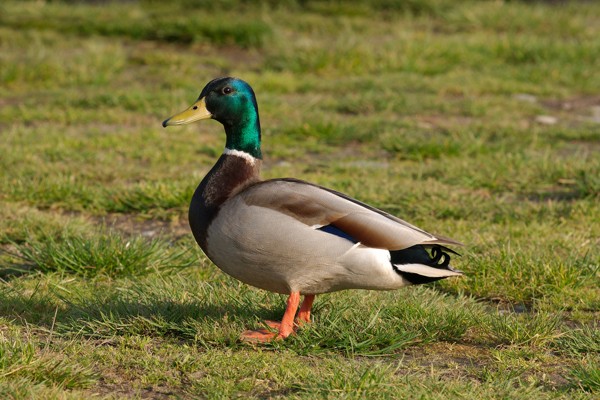
Mallard Duck
The mallard (Anas platyrhynchos) is one of the most widespread and abundant ducks in North America. Mallards breed anywhere on the continent where open water and food are available at some time during the year from city parks to tundra ponds. Almost all domestic ducks, except for the Muscovy duck, come from the mallard.
The most adaptable of ducks, the mallard’s ability to tolerate human activity means it is frequently encountered in urban settings.
The mallard diet is 90% vegetarian consisting of aquatic plants, marsh grasses, sedges, seeds, and acorns. Insects, crustaceans, mollusks, and fish also make up a portion of the diet.
The largest dabbling duck, this heavy-bodied bird typically weighs approximately 1.1 kg (2.4 lb). The male mallard is probably the most easily recognized duck with its brilliant green head; wide, flat, yellow bill; gray flanks, and curly, black tail.
Image of a mallard drake by Derrick Coetzee.
-

Ducklings
Ducklings are precocial. Ducklings quickly leave the nest and most injured or orphaned ducklings are presenting during the first few weeks of life.
- The nesting stage of mallard (Anas platyrhynchos) ducklings is generally limited to 1 day. The normal duckling follows its mother until fledging at 50-60 days of age.
- Wood ducks (Aix sponsa) are tree cavity nesters. Ducklings using their sharp claws to climb out of the nest or they simply leap down, sometimes as far as 60 feet, landing near the mother below. The young are able to fly by day 56-70 days.
Mallard ducklings and wood ducklings appear quite similar, however correct identification is critical because these species have very different husbandry requirements. Wood ducklings are relatively carnivorous, feeding on fish and aquatic insects. Wood ducklings are also much more shy and high-strung in captivity.
- Mallard ducklings are yellow-gold below and brown-gold above. A prominent, dark eyeline extends from the nares, and a brown cap extends over the crown. A second brown mark is usually present below the eyeline. The legs are brown.
- When mallards hybridize with domestic ducks, the young have yellow-orange legs, relatively large feet, and more yellow in their down feathers. These individuals should be placed in homes with other domestic ducks.
- Wood ducklings are less yellow than mallard ducklings. They also have shorter tails, lighter, cream-colored breasts, and the eyeline extends only from the crown to the eye. Wood ducklings are also noticeably smaller than mallard ducklings.
Image of a mallard duck and her ducklings by M. Harky.
-

American Green-Winged Teal
The American green-winged teal (Anas crecca) is found in tight flocks on shallow, marshy, or muddy ponds throughout the Americas. Birds breed throughout much of Canada, Alaska, and the northern United States. The winter range includes the western and southern United States as well as Mexico.
The teal is the smallest dabbling duck in the Americas. This compact, agile species typically weighs 350 g (12 oz).
- Male teals have a reddish-brown head with an iridescent green crescent spanning from one eye, around the back of the head, to the other eye. The wings and tail are tannish-brown color, with pale yellow feathers along the side of the tail.
- Females are tan-brown with a white chin and belly.
- Bills are narrow and black.
During the summer months, its diet consists of aquatic inverts, tadpoles, seeds, and aquatic vegetation. During the fall, birds eat grain, grasses, seeds, and plant shoots. Ducklings feed on insects and other invertebrates and vegetation.
Image by B. Heise.
-

Mandarin Duck
The Mandarin duck (Aix galericuluata) lives in the forests of China and Japan. In these countries it is considered a symbol of happiness and marital fidelity. There is also a small feral populations in Great Britain and California.
Like most ducks, Mandarin ducks exhibit sexual dimorphism:
- Males possess a crest of orange and cream feathers, and a broad white eye-stripe that is bounded above and below by darker feathers.
- The female is gray with a curving, white stripe behind the eye and a series of white blotches underneath.
The Mandarin duck’s diet primarily consists of aquatic vegetation, rice, and grains.
Image of a Mandarin drake by F. Vassen
-
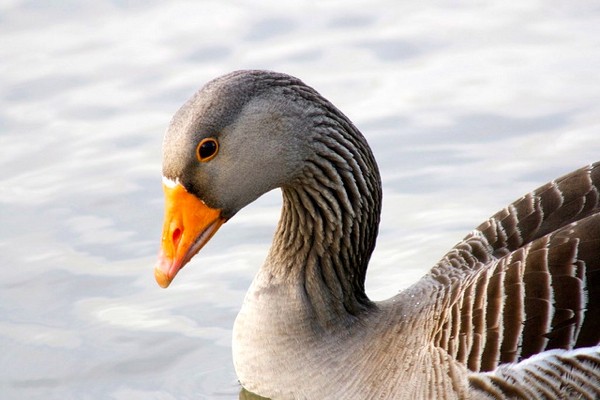
Greylag Goose
The greylag or barnyard goose (Anser anser) is a domestic species native to Europe and parts of Asia. This species has been domesticated for thousands of years. The standard or wild type is gray, but there are many variations in size and color. This species is large and bulky, bred to provide a lot of meat. Males typically weigh 3.5-3.8 kg (7.7-8.4 lb); females range from 2.7-3.1 kg (6.0-6.8 lb).
Greylag geese consume a variety of foodstuffs, however plant material like grass, roots, leaves, stems, seed-heads, and sprouts, make up the bulk of the diet.
Image by Aubergene.
-

Toulouse Goose
The Toulouse goose is a gray goose descended from the European graylag goose that is popular as a pet because of its quiet, gentle temperament. This large, blocky bird has a dewlap and loose feathers that give the Toulouse goose a soft appearance. Like all breeds descended from the graylag goose, the feathers on the sides of the neck are deeply furrowed. Their primary color is gray, with a pearly gray being preferred.
The American Livestock Breeds Conservancy recognizes three types:
- Production: The most popular type of Toulouse goose often found on small farms. Production Toulouse have large, oval heads; relatively long, heavy necks; and thick, wide bodies. Production Toulouse weigh 8.2-9.0 kg (18-20 lb).
- Standard Dewlap: Bred for its ability to rapidly gain weight when force-fed, the standard dewlap is used to make fois gras.
- Exhibition: A decorative show bird with an exaggerated dewlap and keel. Females weigh 9.0-10.9 kg (20-24 lb), ganders 11.8-13.6 kg (26-30 lb).
Image by ‘Just Chaos’.
-
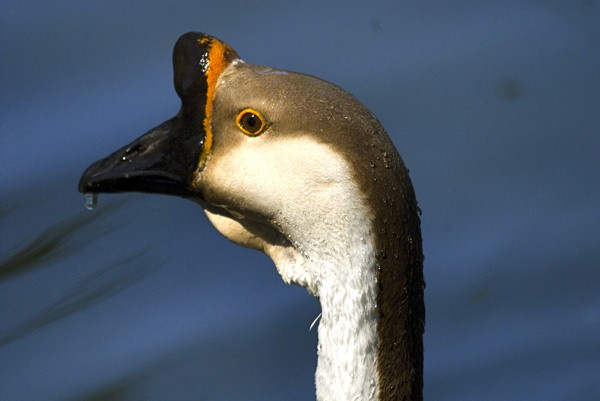
Chinese Goose
The Chinese or swan goose (Anser cygnoides) is a domestic breed descended from wild geese native to East Asia.
The Chinese goose is characterized by a large bill knob in both genders, a long, swan-like neck, and relatively erect posture. Mature ganders average 5.4 kg (12 lb); females average 4.5 kg (10 lb). The Chinese goose is a hardy breed, however their knobs can develop frostbite so it is important to provide some protection from inclement weather.
These geese eat many grasses and herbaceous plants, and many poultry catalogs refer to them as “weeder geese”. Chinese geese are considered an economical breed. They are exceptional layers, active foragers, which means they do not require as much food as other breeds, and they produce good meat. Alert and vocal, Chinese geese also make excellent “watchdogs”.
Image by Chuck Abbe.
-
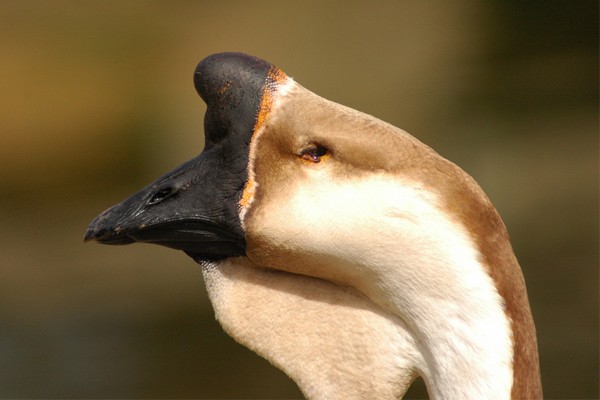
African Goose
The exact origin of the African goose is unclear, however this breed is related to the Chinese goose and may have come from China.
This massive bird has a heavy body, large head, thick neck, stout bill, and a smooth, crescent-shaped, cream-colored dewlap that hangs from the lower jaw and upper neck. The mature bird has a large knob attached to its forehead, which requires several years to develop. Body feathers are ash brown edged with a lighter shade. African geese are also quite long. Their relatively erect posture allow birds to achieve a height of 0.9 m (3 ft). Show birds can reach a weight of 11.8 kg (26 lb), however the mature gander averages 10 kg (22 lb), while a mature goose (female) averages 8.2 kg (18 lb).
African geese can withstand considerable cold weather but need shelter to protect their knobs from frostbite. Knobs that have developed frostbite often develop orange patches that usually disappear by fall.
Image by Zyada.
-

Pilgrim Goose
Traditionally thought to have come to America with the pilgrims, the pilgrim goose, as we know it, is a relatively new breed.
Pilgrims are medium-sized geese, weighing 5.9-6.4 kg (13-14 lb) at maturity. The pilgrim goose is described as an “auto-sexing breed” because sexual dimorphism based on coloration occurs in goslings and mature adults.
- Day-old males are silver-yellow with light-colored bills. Females are olive-gray with their darker bills.
- Adult ganders are mostly white, usually with gray rumps (which are covered by the wings). Mature geese (females) are a soft dove gray with variable amounts of white in their faces. Eyes are blue in ganders and dark brown in geese.
- Bills and legs are orange in both sexes.
The pilgrim goose is a calm, quiet, personable bird.
Image by ‘scillystuff’
-
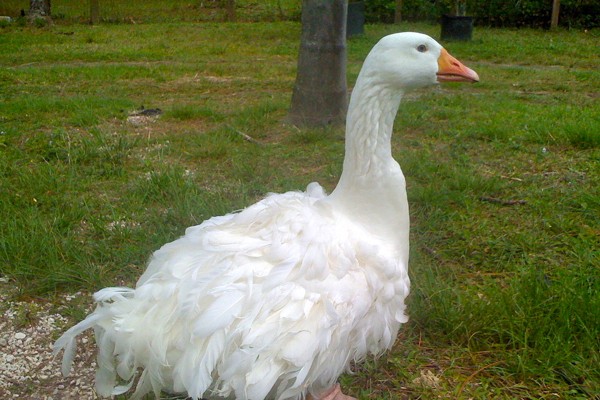
Sebastopol Goose
Sebastopol geese originated in southeastern Europe, from the region around the Black Sea.
Sebastopols are medium-sized geese, weighing 5.4-6.4 kg (12-14 lb) when mature. They have large, round heads, prominent eyes, slightly arched necks, keel-less breasts and fatty lobes that hang below the abdomen. Most Sebastopols are white with bright blue eyes and orange bills and feet, There are also gray and buff color varieties. There are two plumage forms: the smooth-breasted and the frizzle, which has long, soft-quilled, curling feathers all over except for the head and upper neck. The curled feathers prevent flight making this breed easier to confine.
Sebastopols are hardy birds that are relatively cold tolerant. Sebastopols produce good quality meat for roasting.
Image by Davee.
-

Canada Goose
The Canada goose (Branta canadensis) is the most widespread goose in North America. This species can adapt to widely diverse habitats and is found in the Artic, Alaska, the Northwest Territories, Canada, continental United States, and Mexico.
Canada geese are extremely variable in size ranging from 1.4-4.5 kg (3.5-9.8 lb).
Depending on the reference consulted, there are anywhere from six to eleven subspecies or races. All groups have a black bill, black neck, black legs and feet, dark brown to gray-brown back, wings, sides and breast, white flank and belly, plus a distinctive white cheek patch.
The species is sexually monomorphic, however birds less than 1 year of age have notched tail feathers and an indistinct color division between their black neck and gray breast. Birds less than 1.5 years have pointed, rather than rounded, primary feathers.
Canada geese are herbivores. The diet consists of grasses, aquatic vegetation, seeds and grains. Preferred foods include wheat, ryegrasses, clover, and common landscape grasses like bluegrass and fescue.
Canada geese mate for life and the bond is so strong that if one of the pair is unable to fly, the other will elect not to migrate. Both parents raise the young.
Image by Tony Hisgett.
-
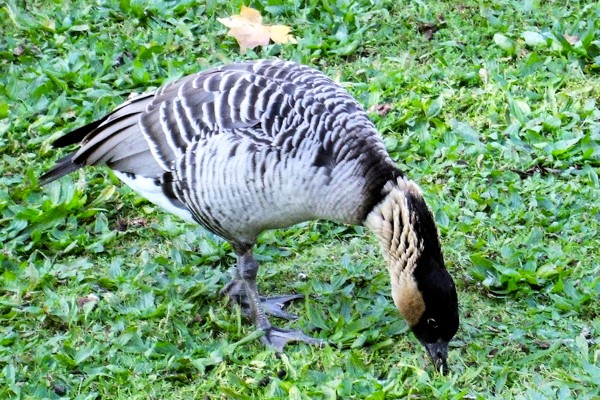
Hawaiian Goose
The Hawaiian goose or Nēnē (Branta sandvicensis) is native to the Hawaiian islands, where it occupies a variety of habitats ranging from grasslands and scrub forests to sparsely vegetated volcanic slopes. Early Hawaiian settlers hunted Nēnēs to near extinction. A hunting ban was placed in 1907 and Nēnēs were named the state bird in 1957. Captive breeding efforts and protection of nesting areas have helped this endangered bird, and today the wild population is slowly recovering. Their greatest threat is predation of eggs by the introduced Indian mongoose.
The body and wings are dark brown or dark brown-gray in adult Nēnēs. The face and crown are black, cheeks are cream-colored, and the neck is buff with black streaks. The eyes, beak, and feet are also black. Nēnēs have relatively long legs and less toe webbing than other geese, which helps them to walk on lava flows. This species is sexually monomorphic.
Nēnēs are herbivores and forage solely on land. The diet consists of leaves, grasses, flowers, berries, flowers, and seeds.
Nēnēs form life-long pair bonds.
Image by Jim Linwood.
-
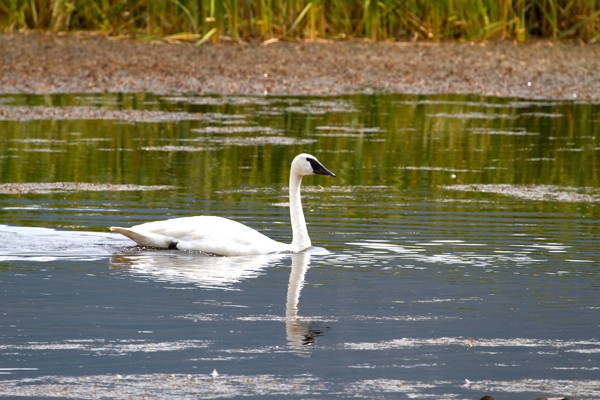
Trumpeter Swan
The trumpeter swan (Cygnus buccinators) was pushed out of American breeding grounds by development and agriculture, leading to near extinction by the 1930’s. Full protection enabled this species’ recovery and this bird has returned to parts of its former range. Today trumpeter swans are found in Alaska, Canada, and the northern United States. Birds live on land, but always in close proximity to salt, fresh, or brackish water.
The trumpeter swan is North America’s largest swan, weighing up to 10.5 kg (23 lb) Wingspan can often exceeds 2 m (6.6 ft). The trumpeter swan is sometimes confused with the tundra swan, but its neck and bill are longer. The bill also has a relatively straight base. The cygnet’s bill is sometimes pink but is always black at the base. The feet and tarsi legs may be grey-yellow. The body is light to dark grey, and gradually whitens with age. By 2 years of age, most but not all feathers have turned white.
The juvenile diet consists primarily of aquatic invertebrates, however by 5 weeks most cygnets have converted to a nearly herbivorous diet. The adult diet consists of leaves, seeds, tubers, roots, crustaceans, and occasionally small vertebrates and insects.
Image by B. Gratwicke
-
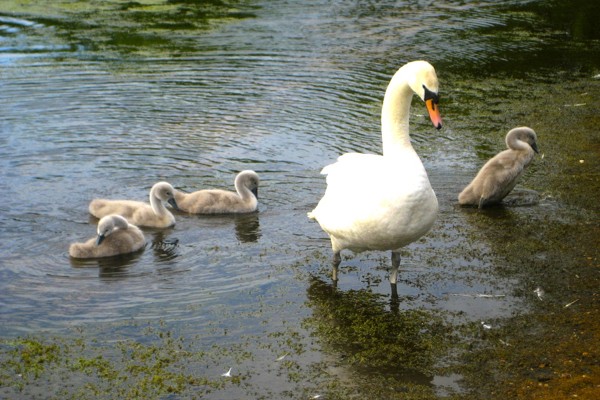
Mute Swan
Introduced from Europe, mute swans (Cygnus olor) are well established in North America, especially on the East coast. In fact, their successful introduction and expansion in North America has created significant problems for native wildlife like common loons (Gavia immer) and trumpeter swans (Cygnus buccinators). Mute swans are aggressive, and have been known to drive off similarly sized species.
The mute swan has a relatively heavy, gently curved neck, pale bill with a dark, distinctive base and a tail that is longer than other swans. Plumage is white. There is a knob at the base of the upper bill, and the bill is orange with a black tip and base. Males and females are alike, except that males are generally larger. The average weight is 10 kg (22 lb). Despite its name, this species is NOT mute, but they are usually silent.
The mute swan diet consists primarily of aquatic vegetation, as well as small amounts of aquatic insects, fish, and frogs.
Image by Andy Roberts.
-

Black Swan
Native to the wetlands of southern Australia and Tasmania, black swans (Cygnus atratus) have been introduced to New Zealand, Europe, and North America. Black swans live in lakes, rivers and swampland in fresh, salt or brackish water.
As the name implies, this species is mostly black with a long, arched neck and raised eyebrows. Some of the wing feathers are white. They also have red or pink irises and red bills with a white line. Cygnets are grey-brown with light tipped feathers and a lighter bill. The cob (male) is slightly larger than the female or “pen”.
Black swans eat aquatic vegetation and other plants. They also occasionally eat insects.
Image by Oatsy40.
-
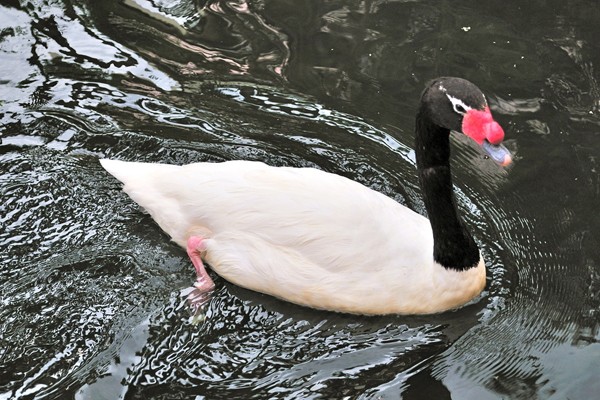
Black-Necked Swan
Black-necked swans (Cygnus melancoryphus) are native to south coastal South America.
Black-necked swans are the smallest members of the genus Cygnus. Males are usually onethird larger than females ranging from 4.5-6.7 kg (9.9-14.8 lb) in weight. Females weigh 3.5-4.4 kg (7.7-9.7 lb). Black-necked swans have a white body and wings with a long, distinctive, black neck and head. The neck and head also sometimes have white speckles. The blue-gray bill has a red base with large, double-lobed, red growths or caruncles. Black-necked swans also have a white stripe behind the eyes that extends towards the back of the neck. The legs are pink and very short. Cygnets are a dull, light brown-gray with black bills and feet. Juvenile birds obtain adult plumage in their second year of life.
Black-necked swans feed mainly on aquatic vegetation, although they will also eat some invertebrates, like insects and rarely fish or tadpoles.
Image by Jim Linwood
























